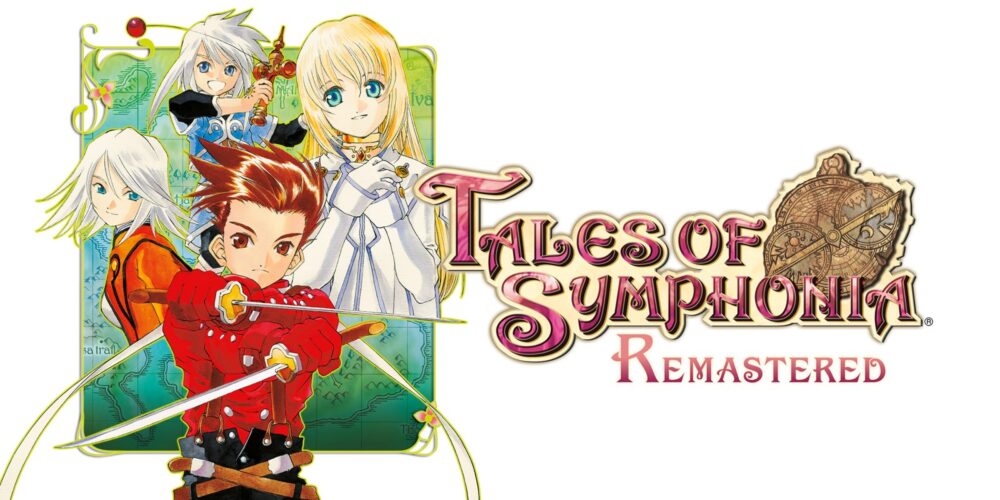Since its release, Tales of Symphonia has been heralded as a classic JRPG and has graced multiple platforms. Its life began on the Gamecube in 2003, with a PS2 port in 2004. In 2013 an HD collected edition, which includes the Wii sequel, hit the PS3 with a Steam release in 2016, making it an old game that hasn’t disappeared from modern hardware and the public eye. Something in itself that is a rarity these days.
Now Tales of Symphonia hits more modern consoles, namely Nintendo’s Switch, PS4 and Xbox One with a remastered edition touting enhanced visuals and gameplay.
Tales of Symphonia is set in the world of Sylverant, a world that is slowly dying as its mana runs out. To save the world, descendants of Angels have to undergo a trial to awaken the goddess Martel. But not everyone wants that to happen and your journey is fraught with peril, double-crosses and sacrifice.
Tales of Symphonia is a fan favourite game in the series, and a classic, for a good reason. There’s a great story at play here, made up of a cast of fantastic characters with satisfying character arcs, rounded off with great exploration and a rather tactical combat system. It still plays like any other number of JRPG’s from this era, or even in this one. There’s a massive world for you to explore, plenty of towns and dungeons to visit and side quests to take on.

Where Symphonia stood apart at the time, was in its visual design and its combat system, which has evolved to become a series staple.
Symphonia ditches the turn-based battling of the time for an action approach, playing a lot more like a 2D action game on a 3D combat arena. You control one character of your party of four while the other three characters are AI controlled, their combat behaviour set beforehand by yourself or left at its default. While the combat arenas and characters may be 3D, control of your character happens on a 2D axis. You can run back and forth, block, unleash special attacks and implement combos based on your D-pad or analogue stick direction.
And as with most JRPG’s, the grind is very real. You’re going to have to sink a fair amount of time into battles if you want to make it through Symphonia’s fights. Combat is challenging and paying attention to enemy attacks and positioning is key to making sure you don’t get wiped out. As well as setting your AI teammate’s behaviours correctly. At their default, they tend to expend all their TP in fights on special attacks and then blindly rush the enemy with basic attacks once their TP pool is empty.
As such, Symphonia plays as you expect a JRPG to play. And with all JRPG’s, it’s the story and characters that will keep you invested.

So what does the Remaster bring to the table?
Symphonia’s remaster is mostly good, but it does come with some caveats. First, you’re obviously looking at the higher display resolution. Symphonia looks clean and crisp in this latest incarnation and rather pretty at times on the Switch’s small screen.
The game’s cel-shaded visuals aren’t as noticeable today as they were back on release, but it’s still a great-looking visual style that manages to stand out. If anything, I’d say certain areas end up having a very watercolour look to the environment. Character models and textures really benefit from higher polygon counts and higher-resolution textures. Towns, cities and dungeons have also received that higher resolution work to bring them up to par with the character models.
Combat arenas, specifically the environment work, have also been dramatically improved. They haven’t just been updated with newer textures, but have also received some extra modelling love. The overworld map though hasn’t received as much work, unfortunately. It sports some blurry-looking textures that do an okay-ish job of denoting grass, sand and trees but I really do wish that higher resolution and more detailed textures had been used.

Some unfortunate issues do mar the presentation, unfortunately. The most glaring issue is that certain areas in the game suffer from extreme slowdown. We’re talking sub-fifteen FPS, walking in treacle kind of slowdown. Initially, I thought it may have to do with the excess of particle effects in one area, but another dungeon that I couldn’t notice any particle effects in also had severe slowdown. It doesn’t make the game unplayable and hopefully, Namco Bandai can get it sorted with a patch in the future.
My last gripe has to do with the camera control in the overworld and enemy placement. You can rotate the camera but you can’t pan it. When you get close to mountains the camera automatically tilts down, which really affects your field of view. On the overworld, you can also see enemies on the map. The problem is that they fade into view when only feet away from your character which makes it difficult to avoid a fight when you’re in a rush. To be fair, this is a remaster and not a remake so expecting old design is the order of the day.
Outside of these issues, Tales of Symphonia is still a great, gripping RPG whose story and characters stand up to the test of time. A battle can be satisfying if you’re paying attention and, for the most part, the visuals look crisp, clean and pretty. If you haven’t played it before, this is a great way to get in on it now. With the Switch’s added addition of being able to play it on the go, as I find most RPG’s these days have been the way to play.
Platforms: Nintendo Switch, PlayStation 4, GameCube, PlayStation 3, PlayStation 2, Xbox One, Microsoft Windows
Grab your copy here https://www.nintendo.co.uk/Games/Nintendo-Switch-games/Tales-of-Symphonia-Remastered-2303488.html#Overview
Enjoy the review? want to read more of our reviews? then click right here to be whisked away to the realm of our opinions.








You must be logged in to post a comment.